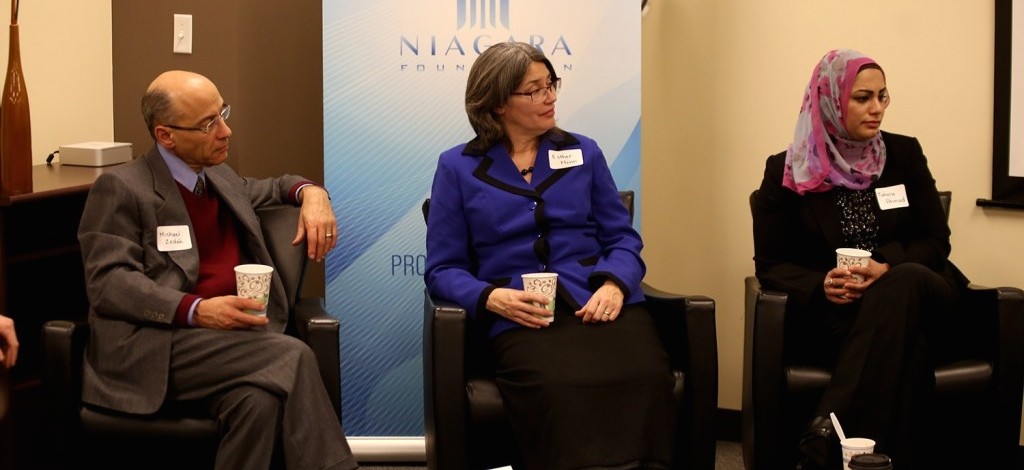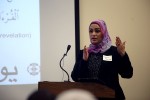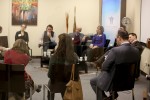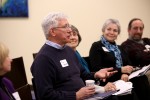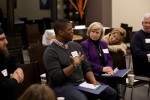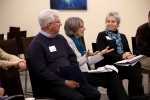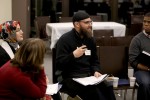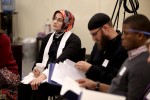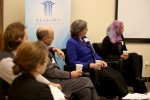Text by: Eleanor Peck
This past Thursday, December 12th, was the inaugural Sacred Sources program, inspired by the academic practice of small group study of sacred texts among Jews, Christians, and Muslims. This invitational program was for religious professionals and we kept it mostly to friends of Niagara, since this was the first experimental program. If you are interested in attending future programming, stay tuned for details in the upcoming months.
Sacred Sources differed from the usual text study practice in a couple ways. First, we gathered about twenty religious professionals together to discuss the text, which is much larger than the usual small group textual study. Additionally, we had three panelists present an academic reading on how each religion views the Joseph story before moving into the group discussion.
Our panelists were Rabbi Zedek of Congregation Emanuel, Esther Menn of Lutheran School of Theology at Chicago, and Tahera Ahmad, Associate Muslim Chaplain at Northwestern University. Each panelist was asked to answer three questions: What the story meant in their tradition, what it meant for them personally, and any unanswered tensions that presented themselves during the reading.
Rabbi Zedek spoke about how in Judaism, every word or phrase in the Torah has a meaning. So the repetition in the phrases “the pit was empty; there was no water in it. Then they sat down to eat” was clearly important. Zedek said that to him, this was the Torah’s way of reinforcing the brothers’ truly despicable behavior. Not only did they throw their brother down into a pit, but they also sat down to a “picnic” while he had nothing, not even water to drink. He also spoke about the importance of knowing the Hebrew for Jews because nuance is lost in the translation. An example he gave was when Pontifer’s wife is attempting to seduce Joseph and he refuses. Joseph’s refusal in the Hebrew makes use of a rare character that when sung, clearly shows how Joseph maybe “struggles” in making his decision not to succumb to her advances. When Rabbi Zedek sang the line in the Hebrew, everyone in the audience, including those of us who don’t know Hebrew, could hear Joseph hemming and hawing during his refusal of her advances.
Esther Menn spoke about the importance of the Joseph story for children, a point brought up again in the group discussion. The values, the characters and the plot of the story are all things children can relate to and apply to their everyday life. She also spoke about how when reading this story again recently, as we all did in preparation for the event, she was struck by how much Mandela’s story paralleled the Joseph story considering the righteous imprisonment and the reconciliation aspects. Later, in the group discussion, Gerald Hankerson, Outreach director for CAIR, related the struggle to influential civil rights leaders, like Martin Luther King Jr. and Malcolm X.
During her presentation, Tahera Ahmad introduced the audience to some influential Sunni philosophers of whom she carefully cited. Similarly to Ms. Menn, she also spoke about how the Yusuf story is also important for Muslim children. She then explained the timeline Qur’anic revelation and located where Surah Yusuf fell to Muhammad and where the Yusuf story was on that timeline. The Yusef story was revealed near the end of the prophet’s time in Mecca, before he immigrated to Medina. According to Ahmad, this was a particularly hard time in Muhammad’s life, which is perhaps why such an inspiring story was revealed then. In fact, the first line of the Yusuf story in the Qur’an is “We tell you (the prophet) the best of stories in revealing this Qur’an to you.” Ahmed said when she was at her Islamic seminary, going through a rough period, her professor told her that it was time to “go in Joseph’s prison” and memorize Surah Yusuf. For Ahmad, this story always brings back that time of her life, when, just like the Prophet Muhammad, she was aided by the “best of stories.”
During the group discussion, in order to facilitate inclusion and disciplined sharing in a diverse environment, we used the process of mutual invitation. The process allows for each person in the group to have an opportunity to share, as well as to participate. Everyone spoke and brought up the part of the Joseph story that moved them the most, as well as what part they enjoyed learning about from the panelists. It was a thoughtful discussion, and near the end Ayse Arslan Cinar, Vice President at the Niagara Foundation, brought up a beautiful idiom relating to the Joseph story from her home country of Turkey “You can’t become Joseph until you’ve been in the well” meaning, of course, that pain and sacrifice are required for true leadership. It was a fitting end to the first installment of Niagara’s newest program, Sacred Sources.

